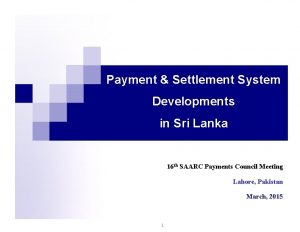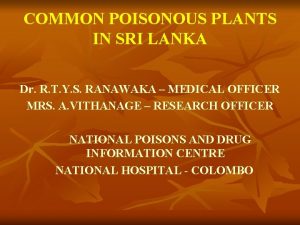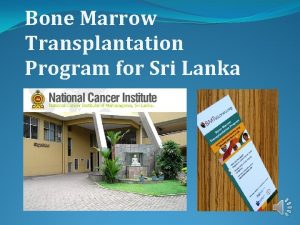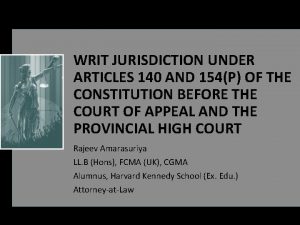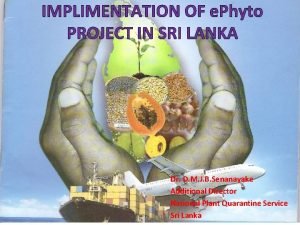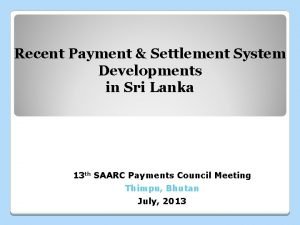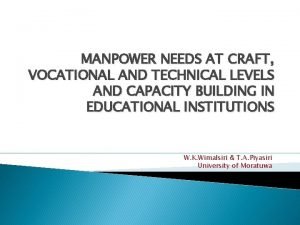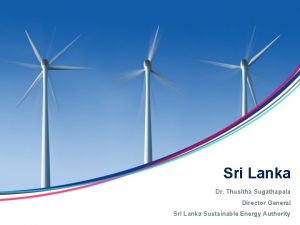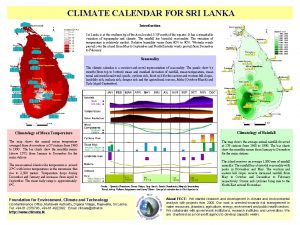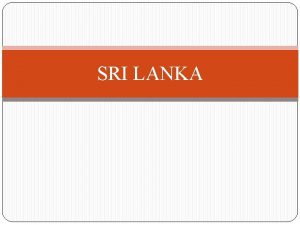Sri Lanka Dr Thusitha Sugathapala Director General Sri













- Slides: 13

Sri Lanka Dr. Thusitha Sugathapala Director General Sri Lanka Sustainable Energy Authority

Energy Sector Overview • Population: 20. 65 million • Electrification Rate: 89% • Population Connected to Grid: 87% • Energy Stakeholders: Ceylon Electricity Board and Private Power Producers

Power Generation • Total Power Generation: 10, 714 GWh in 2010 • Power Generation Mix Hydro Thermal Wind Gross Generation small hydro (GWh) Domestic Religious Demand Industrial Energy by Sector. Street Lighting 1. 59% Commercial 24. 60% 3; 0%549; 6% 40. 18% 3356; 34% 5975; 60% 33. 03% 0. 61%

Renewable Energy • RE Policy highlights: – The Government has set clear policy targets to develop NCRE resources. – The Government envisions increasing the share of NCRE by 10% in grid electricity by 2015 and further increasing the target to 20% by 2020. • Wind Target: – 85 MW by 2015 – 300 MW by 2020

Electricity Cost: Subsidies and Incentives • Fossil Fuel Subsidies – Furnace oil for power generation is given to CEB with a subsidy of about 0. 18 US$/liter – The fossil fuel subsidy then becomes 0. 04 US$/k. Wh • RE Subsidies – Cost reflective tariff, which is higher than the average selling price – Average selling price = 0. 119 US$/k. Whr – Additional cost of RE is passed to the customers

Electricity Cost: Subsidies and Incentives • RE Subsidies RE Source Base Rate ($/k. Wh) Subsidy ($/k. Wh) Wind 0. 177 - Solar Biomass (Dendro) Biomass (Residues) MSW 0. 188 0. 132 0. 200 - Mini Hydro Waste Heat Other 0. 119 0. 060 0. 188 -

Wind Resource Potential • Country Wind Potential: NREL Study

Wind Resource Potential • Country Wind Potential: Measurements by SEA

Total Installed Wind Capacity as of December 2010 Operational Wind Projects MW Year Mampuri WPP - Senok Wind Power (Pvt) Ltd 10 2010 Seguwantivu WPP - Seguwantivu Wind Power (Pvt) Ltd 10 2010 Vidatamunai WPP - Vidatamunai Wind Power (Pvt) Ltd 10 2010 0. 15 2010 Willpita WPP - Willwind (Pvt) Ltd TOTAL 30. 15

Additional Wind Capacity Pipeline of Wind Projects MW Estimated Year 1. Senok Wind Resources (Pvt) Ltd (Mampuri III) 2. Senok Wind Energy (Pvt) Ltd (Mampuri II) 3. Ace Wind Power (Pvt) Ltd 5. 4 2012 2875 10 3 2012 2875 247 4. Nirmalapura Wind Power (Pvt) Ltd 10 2012 2414 5. Power. Gen Lanka (Pvt) Ltd 10 2012 1, 730 Euro 6. LTL Holdings (Pvt) Ltd 9. 8 2012 2859 7. Nala Dhanavi (Pvt) Ltd 4. 8 2012 1428 8. Ambewala Wind Power (Pvt) Ltd 1. 1 2012 150 9. DLR Energy (Pvt) Ltd 10 2012 1909 TOTAL 64. 1 Estimated Cost (LKR mn)

Issues • Capacity / Grid limitation is one of the main barriers for further development of wind power – Sri Lanka’s load profile features a deep off-peak valley and a very sharp evening peak. Operation of wind plants in high wind seasons (coinciding with the high hydro season) during off-peak hours has severely restricted future development. – At present, power purchase agreements feature a forced shut down period during off-peak periods. – Finding suitable development land is becoming very difficult. – Lack of transmission capacity in windy locations also constraint wind development. – Central highlands are inaccessible for wind development.

Issues • Lack of Economic Benefits – Modern Wind Technology today is alien to Sri Lanka, with very little room for local value addition. – Very few jobs were created in Sri Lanka.

Next Steps • Future development of wind power – A very attractive tariff of around USCts. 20/k. Wh is on offer. – Sri Lanka has become a crowded market place for wind energy development ! – Wind industry require a robust implementation mechanism which in essence should be based on competitive bidding systems - NOT on first come first served basis as at present. – Future projects will be on a larger scale, targeting public private partnerships as the basis for investment. – Identify what positive outputs will be available from developing wind, such as employment creation, technology transfer & local value addition, foreign exchange saved, etc.
 Sri rama sri rama sri manoharama
Sri rama sri rama sri manoharama Aaseevagam religion
Aaseevagam religion Payment and settlement system in sri lanka
Payment and settlement system in sri lanka Disaster management centre sri lanka
Disaster management centre sri lanka Sri lanka institute of information technology affiliations
Sri lanka institute of information technology affiliations Poison plants in sri lanka
Poison plants in sri lanka Cusdec
Cusdec Nigel barker sri lanka
Nigel barker sri lanka Bone marrow transplantation sri lanka
Bone marrow transplantation sri lanka Writ jurisdiction in sri lanka
Writ jurisdiction in sri lanka Sri lankan vegetables
Sri lankan vegetables Payment and settlement system in sri lanka
Payment and settlement system in sri lanka Maha ravana
Maha ravana Nvq levels in sri lanka
Nvq levels in sri lanka


